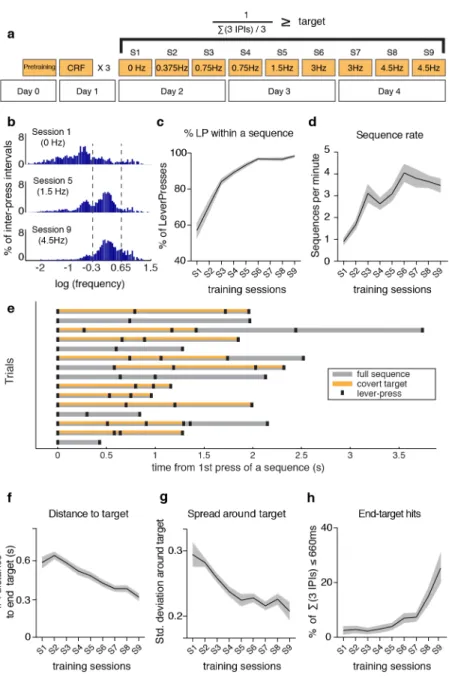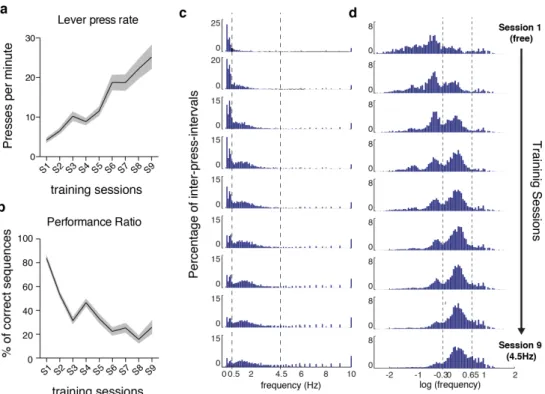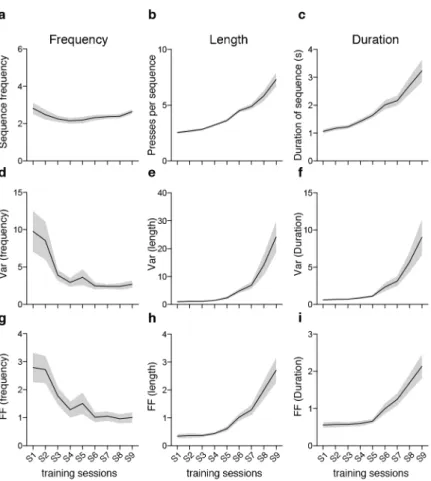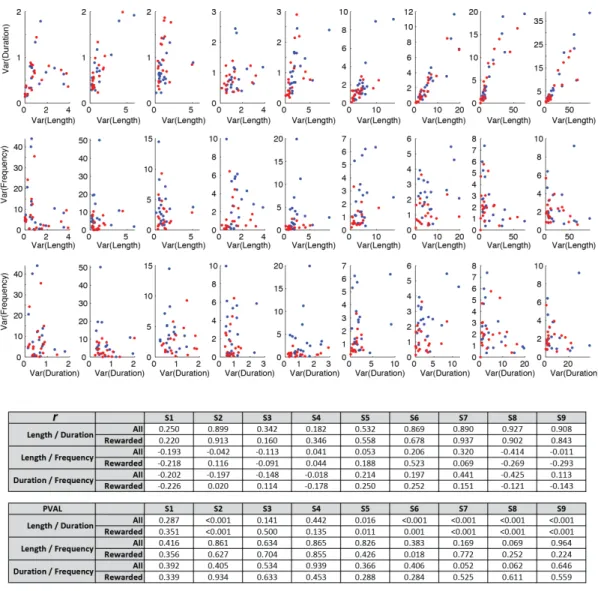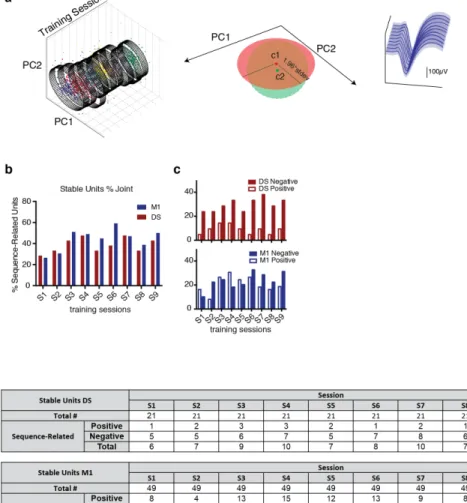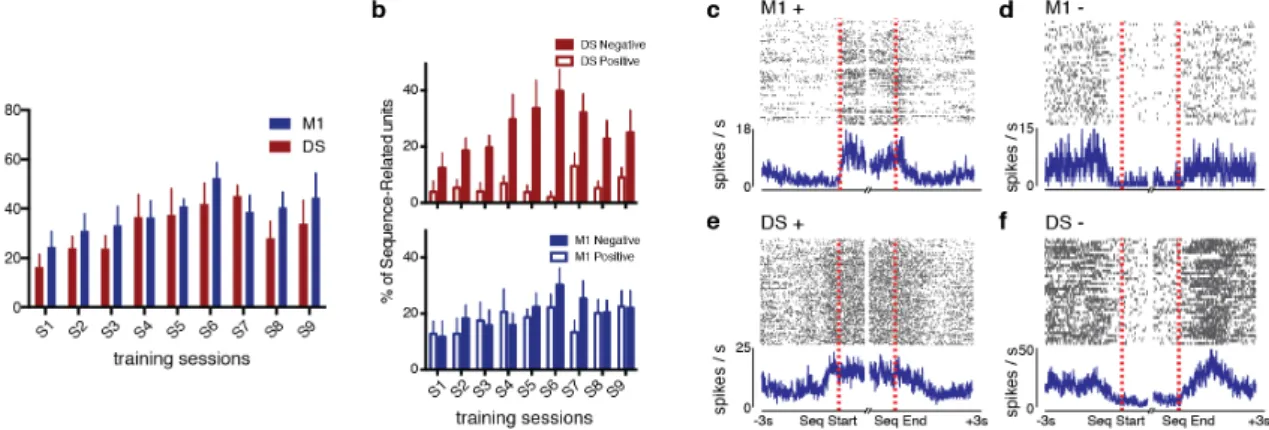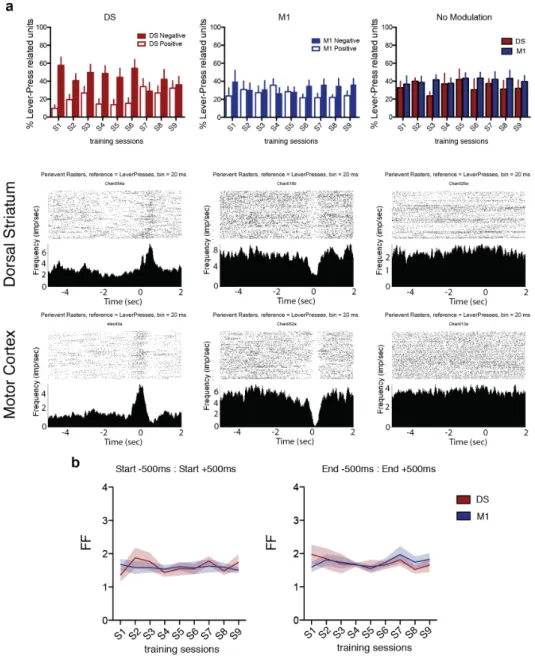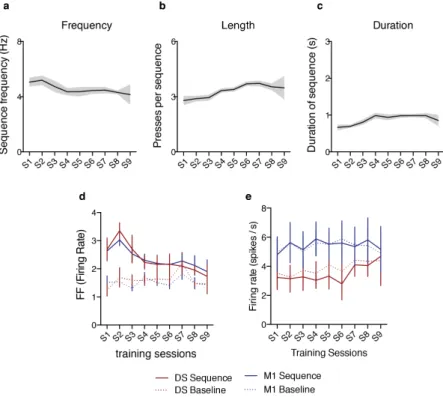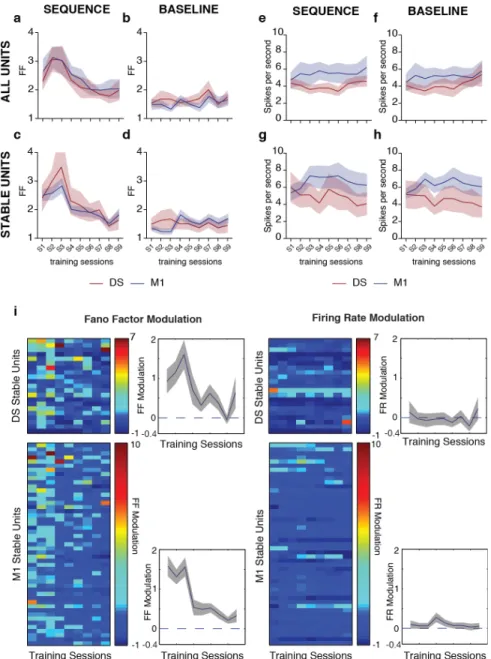Fernando J. Santos
Dissertation presented to obtain the Ph.D degree in Biology | Neuroscience
Instituto de Tecnologia Química e Biológica António Xavier | Universidade Nova de Lisboa
Oeiras,
January, 2015
Learning new tricks:
Corticostriatal dynamics during novel skill learning
Fernando J. Santos
Dissertation presented to obtain the Ph.D degree in Biology | Neuroscience
Instituto de Tecnologia Química e Biológica | Universidade Nova de Lisboa
Research work coordinated by:
Oeiras,
The work presented in this dissertation was carried out under the International Neuroscience Doctoral Programme (INDP, at the Champalimaud Neuroscience Programme, Champalimaud Centre for the Unknown, Lisbon, Portugal) under supervision of Dr. Rui M. Costa. Financial support was given by a doctoral fellowship from the Portuguese Science and Technology Foundation (FCT, Fundação para a Ciência e Tecnologia), with the reference SFRH/BD/33941/2009 attributed to Fernando João Antunes Gomes dos Santos.
ACKNOWLEDGEMENTS
To my parents, Fernando and Fernanda, who made all this possible by providing me the tools to thrive in any situation. Their example, their values and their education are undoubtedly the best skills I will ever acquire;
To my sisters, Daniela and Mariana, for their support and for always making me feel special even when I spent so much time far from home; To Adriana, for all the patience and care during so many years of hard work and frustration;
To Cristiana, for bringing the best out of me, making me a much better and happier person, and for showing me that life can be so much fun; To the Neurobiology of action folks, for all the discussions and insight, the long hours at the lab, but mostly for making me feel at home and surrounded by friends all the time;
To the CNP, an amazing group of people that managed to create a place and an environment where anyone would love to work;
To Rui, for being a mentor, an example and a friend.. and for making every piece of data, either good or bad, every experiment, either a sucessful or failed one, into something extraordinary, and more importantly, into a learning experience.
“If I have seen further it is by standing on the shoulders of giants”
RESUMO
A aprendizagem de novas ações e habilidades motoras é uma capacidade prevalente em múltiplas espécies animais e uma característica crítica para a sobrevivência e competência num mundo em constante mudança. A geração e aprendizagem de novas ações ocorre através de um processo de tentativa e erro, no qual um animal explora o ambiente que o envolve, gerando múltiplos padrões de comportamento e selecionando aqueles que aumentam a probabilidade de consequências positivas. A adaptação e execução correta do padrão comportamental selecionado requer a coordenação de várias propriedades biomecânicas pelo animal, e os circuitos corticais e dos gânglios da base são conhecidos por estarem envolvidos nos processos relativos à aquisição, aprendizagem e consolidação de habilidades motoras.
Nestes estudos tentámos expandir o conhecimento relativo ao processo de aprendizagem e aquisição de uma habilidade motora nova. Utilizando uma tarefa operante difícil e complexa, demonstramos que os animais otimizam as componentes de uma sequência de ações que são relevantes para obter os resultados desejados. As componentes comportamentais são dinamicamente alteradas com base na sua relevância para a tarefa motora. Com o treino, há uma redução na variabilidade das componentes relevantes para a tarefa, que interferem diretamente com o objectivo da tarefa, não sendo esta redução observada ao nível da variabilidade das componentes não-relevantes, que não interferem com o objectivo da tarefa. A atividade dos circuitos córtex-estriado foi gravada de forma contínua, permitindo-nos seguir populações específicas de neurónios e avaliar alterações da sua
atividade que possam emergir com o treino de uma tarefa motora. Observámos que nas sessões iniciais há um aumento da variabilidade na atividade destes circuitos córtex-estriado, e que esta variabilidade diminui ao longo do processo de aprendizagem e das sessões de treino. Nestes estudos demonstrámos que estas dinâmicas neuronais estão especificamente correlacionadas com as dinâmicas das componentes comportamentais relevantes, que verificámos serem dependentes da existência de plasticidade sináptica nos circuitos córtex-estriado. A aprendizagem por tentativa e erro requer uma exploração inicial, de modo a analisar diferentes estratégias, resultando numa elevada variabilidade comportamental, putativamente causada por um aumento da variabilidade na atividade neuronal. O processo de aprendizagem promove uma adaptação gradual para uma estratégia de utilização de recursos, na qual o animal seleciona o padrão comportamental e neuronal que maximiza o resultado da tarefa. Nestes estudos testámos esta hipótese de seleção diretamente ao nível dos circuitos córtex-gânglios da base, utilizando um interface cérebro-máquina que nos permite reforçar um padrão de atividade neuronal específico. Verificámos que o emparelhamento explícito de um padrão neuronal experimentalmente definido, com uma ativação de neurónios dopaminérgicos, é suficiente para promover uma alteração na ocorrência deste padrão de atividade.
Em suma, os estudos apresentados nesta dissertação fornecem novas evidências para a teoria de seleção como base para a aprendizagem motora, integrando dados comportamentais e neuronais, de forma consistente com as teorias de feedback otimizado para controlo motor. Para além disso, a caracterização de uma tarefa motora de uma forma sistemática e menos dependente das especificações de cada paradigma, pode constituir uma estratégia útil para comparação de
resultados não só entre diferentes tarefas motoras, mas também entre tarefas de aprendizagem de memórias não-motoras.
SUMMARY
Learning novel actions and skills is a prevalent ability across multiple species and a critical feature for survival and competence in a constantly changing world. Novel actions are generated and learned through a process of trial and error, where an animal explores the environment around itself, generates multiple patterns of behavior and selects the ones that increase the likelihood of positive outcomes. Proper adaptation and execution of the selected behavior requires the coordination of several biomechanical features by the animal. Cortico-basal ganglia circuits and loops are critically involved in the acquisition, learning and consolidation of motor skills.
In these studies, we investigate the process of learning and acquisition of a novel motor skill. Using a difficult and complex operant task, we demonstrate that animals optimize the features of a sequence of actions that are relevant to obtain the desired outcome. Behavioral features are dynamically refined based on their relevance level to the task. Animals reduce variability in outcome-relevant features, which directly subserve the goals of the task, while there is no reduction in the variability of non-relevant features, which are unimportant for the task outcome. Activity of corticostriatal circuits was continuously recorded throughout learning, allowing us to follow specific populations of cells within these neuronal circuits and to monitor changes of activity that emerge with training of a motor skill. We demonstrate that in early sessions activity within corticostriatal circuits exhibit enhanced variability, and that this variability decreases as the animals progress through the training sessions. We show that neuronal dynamics are specifically correlated with the changes in the outcome-relevant behavioral features, which are
dependent on functional corticostriatal plasticity. These data provide support to the concepts of exploration and exploitation as basis for motor skill learning.
Trial and error learning requires initial exploration of different behavioral strategies, which results in increased behavioral variability, putatively caused by elevated neuronal variability. Learning promotes a gradual shift towards more exploitive strategies and a subsequent selection of behavioral and neuronal patterns that maximize the outcome of the task. We directly test this selection hypothesis within the cortico-basal ganglia networks by taking advantage of a brain-machine-interface paradigm to reinforce a specific spatiotemporal pattern. Pairing of an experimentally defined neuronal pattern with a phasic activation of dopaminergic neurons is sufficient to increase the likelihood of occurrence of this pattern.
Taken together, the studies presented in this dissertation provide further evidence of selection as a foundation for motor skill learning. The presented work integrates both behavioral and neuronal data in a framework consistent with optimal feedback as a general principle for motor control. Furthermore, characterization of an operant task in a systematic way, and less dependent on the specifics of each paradigm, might be a useful strategy to compare our results with different motor tasks, but also with other types of memory acquisition paradigms.
CONTENTS
ACKNOWLEDGEMENTS _____________________________________ 3!
RESUMO __________________________________________________ 5!
SUMMARY ________________________________________________ 8!
CONTENTS _______________________________________________ 10!
ABBREVIATIONS LIST _____________________________________ 13!
CHAPTER 1 | INTRODUCTION _______________________________ 15Motor learning: Behavior and neuronal dynamics ___________________________ 17
!
Motor and neuronal variability during motor learning _________________________ 23!
Brain-machine-interfaces as paradigms for understanding the neuronal dynamics of learning _________________________________________________________ 27!
AIMS: Neuronal and behavior dynamics of action learning ___________ 28
!
REFERENCES ________________________________________________ 29!
CHAPTER 2 | CORTICOSTRIATAL DYNAMICS ENCODE THE REFINEMENT OF OUTCOME-RELEVANT VARIABILITY DURING SKILL LEARNING __________________________________________ 37
!
SUMMARY ___________________________________________________ 37
!
INTRODUCTION _______________________________________________ 38!
RESULTS ____________________________________________________ 39!
Outcome-relevant variability is specifically reduced during motor learning ________ 39
!
Variability of motor cortex and striatal activity decreases with learning ___________ 47!
Corticostriatal variability becomes correlated with behavioral variability exclusively in the outcome-relevant dimension ______________________________________ 55!
Corticostriatal plasticity is required for the reduction in outcome-relevant variability _ 58!
METHODS ____________________________________________________ 63
!
Animals ___________________________________________________________ 63
!
Surgery and in vivo extracellular recordings _______________________________ 64!
Behavioral training ___________________________________________________ 65!
Sequences of lever presses ____________________________________________ 66!
Task-related neurons _________________________________________________ 67!
Analysis and statistics ________________________________________________ 67!
ACKNOWLEDGMENTS _________________________________________ 69
!
AUTHOR CONTRIBUTIONS _____________________________________ 69!
COMPETING FINANCIAL INTERESTS _____________________________ 69!
REFERENCES ________________________________________________ 69!
CHAPTER 3 | CLOSED-LOOP REINFORCEMENT OF MOTOR CORTEX ACTIVITY LEADS TO THE SELECTION OF SPECIFIC SPATIOTEMPORAL ACTIVITY PATTERNS _____________________ 73
!
SUMMARY ___________________________________________________ 73
!
INTRODUCTION _______________________________________________ 74!
RESULTS ____________________________________________________ 78!
DISCUSSION _________________________________________________ 81!
METHODS ____________________________________________________ 83!
Animals ___________________________________________________________ 83!
Electrophysiology ____________________________________________________ 85!
Brain-machine-interface paradigm _______________________________________ 85!
Data Analysis and Statistics ____________________________________________ 86!
ACKNOWLEDGMENTS _________________________________________ 87
!
AUTHOR CONTRIBUTIONS _____________________________________ 87!
REFERENCES ________________________________________________ 88!
CHAPTER 4 | DISCUSSION __________________________________ 91
!
ABBREVIATIONS LIST
BMI Brain-machine-interface ChR2 Channelrhodopsin-2 CRF Continuous reinforcement DLS Dorsolateral striatum DMS Dorsomedial striatum DS Dorsal striatum FF Fano factor FR Firing rateGABA γ-aminobutyric acid IPI Inter-press interval ISI Inter-sequence interval
LMAN Lateral magnocellular nucleus of the anterior neostriatum LTD Long-term depression
LTP Long-term potentiation M1 Primary motor cortex MSN Medium spiny neuron NMDA N-methyl-D-aspartate NSP Neural signal processor
PCA Principal components analysis PETH Peri-event time histogram SNc Substantia nigra pars compacta VTA Ventral tegmental area
CHAP TE R 1
1
INTRODUCTION
Congratulations! You have reached page 15! Now lets stop for a second to look backwards and realize how you have arrived here. Hopefully, browsing through these pages did not seem such a big challenge or achievement. But if you think about the complex patterns of movements that your fingers and hands had to perform, from grabbing and picking up this thesis from a table or shelf, to the perfect synchronization of finger muscles each time you flip a page, and the fact that all this was done with such ease and smoothness, are just small examples of the amazing capacity that we have to learn and acquire motor skills. We will go through the next pages, taking advantage of some of these motor skills that you have developed and mastered long ago, and attempt to understand how the process of learning a motor skill occurs, most of the time without us even being aware of it.
The ability to learn and perform motor skills is something that accompanies animals throughout life. From a small child babbling and discovering how to coordinate muscles and limbs in order to start walking or grabbing simple objects, to a more sophisticated stage where we learn how to ride bicycles and play the piano, the process of acquisition, selection and consolidation of novel motor skills, often time taken as granted by most of us, poses itself as an amazing challenge from the scientific point of view.
CHAP
TE
R
1
medial temporal lobe, hippocampus and amygdala removed in an attempt to cure his epilepsy, resulting in a case study that revolutionized the fields of neuroscience and our understanding of memory formation (Corkin, 2002). The case of H.M. is one of the first and most famous research studies that lead to the distinction between two types of memories: declarative (or explicit) and procedural (or implicit).
Declarative memory is the memory of facts and events that can be explicitly stored and retrieved, while procedural memory is the memory of skills and motor execution, such as using tools and moving our body, and is usually acquired through repetition and practice. After his surgery, which was successful in controlling the epilepsy, Molaison displayed a complete inability to form new long-term declarative memories, while maintaining a fully functional working-memory and ability to acquire novel motor skills and procedural memories (although without any explicit memory of having learned or practiced the task). This provided evidence that motor learning relies, at least partially, on brain structures that are separate from those involved in the acquisition of memories related to facts and events (Corkin, 2002).
Evidence from patient H.M. and several other amnesic patients have implicated brain regions like the hippocampus, entorhinal cortex, perirhinal and temporal cortices in the encoding and processing of declarative memories; whereas work in animal models and humans have implicated the cerebellum, basal ganglia and motor cortices of the frontal lobe in the acquisition and storage of procedural and motor memories (Doyon et al., 1997; Karni, 1996; Sanes and Donoghue, 2000) Evidence from patients with striatal dysfunctions due to Parkinson’s or Huntington’s disease, patients with cerebellar damage, and patients with lesions of the frontal motor cortices have given support to the role of cortico-striatal-thalamic and cortico-cerebellar-thalamic loops in motor processing (Doyon et al., 1997; Harrington et al., 2008; Heindel et al.,
CHAP
TE
R
1
1989).
Anatomical, neurophysiological and lesion studies in rodents and non-human primates have further demonstrated the importance and mechanisms through which these brain areas control motor performance and learning (Bolam et al., 2000; Middleton and Strick, 1997; 2000). Motor learning: Behavior and neuronal dynamics
What exactly is motor learning? Although there is not a precise and consensual definition of motor learning, in most tasks and studies it is assessed by a reduction in reaction time and/or errors in motor performance, which is accomplished by changing movement synergies and kinematics. It is a process that occurs through repeated practice, by which movements get to be performed effortlessly and with improvements in accuracy, speed, and coordination (Guthrie, 1952; Schmidt and Lee, 2013; Welford, 1971; Willingham, 1998).
The concept of motor learning encompasses a wide range of learning paradigms: learning to control the gain of a reflex (Ito, 1993), improvement of a reaction time (Laubach et al., 2000), learning a finger tapping sequence (Nissen et al., 1987), or adjusting movements to external perturbations (Brashers-Krug et al., 1996). Skill learning is a specific type of motor learning, that relates to the acquisition of complex movements such as learning to play tennis or to ride a bicycle (Sanes, 2003). Learning complex movements is also usually designated as sequence learning, since the movements are often organized in sequences or chunks (Asanuma and Pavlides, 1997).
Most of the early research on motor learning focused on motor adaptation (Bedford, 1989; Bock, 1992; Caithness et al., 2004; Cunningham, 1989; Krakauer et al., 1999; 2000; Miall et al., 2004; Rabe
CHAP
TE
R
1
et al., 2009; Sainburg and Wang, 2002; Shadmehr and Mussa-Ivaldi, 1994; Shadmehr et al., 2010; Simani et al., 2007; Smith et al., 2006; Thoroughman and Shadmehr, 2000; Welch et al., 2007; Wolpert et al., 1995), which requires the subject to generate a modification in the motor output, with the goal of reducing systematic errors induced by external sensory or force perturbations. Adaptation could be achieved relatively rapidly using a forward model that makes adjustments of the motor commands based on sensory-prediction errors (Shadmehr et al., 2010). Motor skill learning on the contrary, occurs in the absence of perturbation and its main goal is the reduction of variable performance errors (Deutsch and Newell, 2004; Guo and Raymond, 2010; Hung et al., 2008; Liu et al., 2006; Logan, 1988; Müller and Sternad, 2004; Ranganathan and Newell, 2010). Learning and performance are usually bound by the difficulty of the task and involve some form of speed-accuracy trade-off (Reis et al., 2009; Sanes et al., 1990).
Learning a motor skill can occur through a process of trial and error. By repetition, animals can explore their behavioral space and different strategies, evaluating the feedback from both correct and error trials, and selecting the pattern of movements that lead to the desired outcome.
There is growing evidence that skill learning occurs in different phases (Costa et al., 2004; Karni et al., 1998; Luft and Buitrago, 2005): an early phase, with fast improvements, facilitated by explicit knowledge (Stanley and Krakauer, 2013) where the memory is still labile and susceptible to competition and interference (Brashers-Krug et al., 1996; Walker et al., 2003); and a late phase, where the skill can be performed implicitly, evolving slowly and through repetition (Costa et al., 2004; Karni et al., 1998; Ungerleider et al., 2002), becoming consolidated and resistant to interference (Brashers-Krug et al., 1996; Walker et al., 2003).
CHAP
TE
R
1
Skill learning paradigms in both humans and animal models have shown improvements in motor performance, both during training sessions and during the intervals in between sessions (Buitrago et al., 2004a; 2004b; Karni et al., 1998), with a marked increase in performance when subjects are allowed to sleep (Walker et al., 2003). Mental rehearsal without practice can also lead to improvements in movements (Jeannerod, 1995; Mulder et al., 2004).
Several behavioral, electrophysiological, functional imaging and molecular experiments support these different stages of motor skill learning and their distinct behavioral and physiological hallmarks.
In 1973, Bliss and Lomo demonstrated for the first time the mechanism of long-term-potentiation (LTP), giving support for plasticity in neuronal circuits as one of the mechanisms for learning and memory (Bliss and Lomo, 1973). This mechanism has also been postulated to subserve motor learning, and since then, several studies have shown changes in activity and connectivity during motor learning in both motor cortex and striatum (Brasted and Wise, 2004; Classen et al., 1998; Costa et al., 2004; Debaere et al., 2004; Doyon and Benali, 2005; Gandolfo et al., 2000; Grafton et al., 1994; Jenkins et al., 1994; Kargo and Nitz, 2003; Karni et al., 1995; Kleim et al., 1998; 2002; Li et al., 2001; Muellbacher et al., 2002; Nudo et al., 1996; Seitz et al., 1990; Ungerleider et al., 2002; Wise et al., 1998; Yin et al., 2009). Striatal blockage of N-methyl-D-aspartate (NMDA) receptor mediated currents, which are critical for plasticity, severely impairs motor learning (Dang et al., 2006).
It has been widely observed that the activity of many motor cortical cells varies with muscle activity and kinematics (Cheney and Fetz, 1980; Evarts et al., 1983; Fromm, 1983; Humphrey et al., 1970; Thach, 1978), and that population activity of neuronal ensembles within the primary
CHAP
TE
R
1
motor cortex can code for movement features (Georgopoulos et al., 1986). In addition to the described dynamics during motor learning (Classen et al., 1998; Debaere et al., 2004; Gandolfo et al., 2000; Kargo and Nitz, 2003; Karni et al., 1995; Kleim et al., 1998; 2002; Li et al., 2001; Muellbacher et al., 2002; Nudo et al., 1996; Wise et al., 1998), differential activation of motor cortex throughout the different phases of motor learning has also been reported (Karni et al., 1998; Ungerleider et al., 2002). Large changes in topographic organization related to learning were observed within the primary motor cortex (M1) (Karni et al., 1995; Kleim et al., 1998; Nudo et al., 1996), and changes at the single cell level have also been documented (Wise et al., 1998). Network reorganizations in motor cortex are thought to occur through changes in synaptic efficacy induced by LTP (Iriki et al., 1989; Keller et al., 1990). Nevertheless, it is unreasonable to assume that motor cortex is the only site for plasticity in motor systems (Aizawa et al., 1991; Aosaki et al., 1994). Acquisition and execution of a skilled motor task requires the coordinated participation of a number of structures, including motor cortex, basal ganglia, cerebellum, and spinal cord.
The striatum, the major input nucleus of the basal ganglia, displays several changes in neural activity during motor and procedural learning (Barnes et al., 2005; Brasted and Wise, 2004; Carelli et al., 1997; Debaere et al., 2004; Doyon et al., 1996; Grafton et al., 1994; Jenkins et al., 1994; Jog et al., 1999; Seitz et al., 1990; Ungerleider et al., 2002), and the striatal circuits engaged during the early and late phases of skill learning also differ (Costa et al., 2004; Miyachi et al., 1997; 2002). As the entry point to the basal ganglia, the striatum stands in a relevant position to integrate information from the cortex, thalamus and modulations from the midbrain dopaminergic areas. The majority of neurons within the striatum (90-95%) (Kemp and Powell, 1971) are
CHAP
TE
R
1
medium spiny projections neurons (MSN), which are inhibitory GABA-ergic (γ-aminobutyric acid) cells (Kita and Kitai, 1988). MSNs receive excitatory, glutamatergic inputs mainly from the cortex but also from thalamus and amygdala (Voorn et al., 2004). The cortico-striatal-thalamic loops play an extremely important role in the control of goal-directed and habitual actions. Within the dorsal striatum of rodents, the most medial region (dorsomedial striatum, DMS, homologous to the caudate in primates) receives its major input from the associative cortical areas, while the most lateral region (dorsolateral striatum, DLS, homologous to the putamen in primates) receives its input from sensorimotor cortex (Haber, 2003; McGeorge and Faull, 1989; Voorn et al., 2004). The associative cortico-basal ganglia loop that courses through the DMS seems to be preferentially involved in the initial stages of visuomotor learning and during the rapid acquisition of action-outcome contingencies (Miyachi et al., 1997; 2002; Yin et al., 2005); while the sensorimotor cortico-basal ganglia loop that courses through the DLS is critical for the slower acquisition of automatic and habitual behaviors (Miyachi et al., 1997; 2002; Yin et al., 2004). Yin and colleagues (Yin et al., 2009) confirmed the differential involvement of the striatal areas in the different stages of skill learning through electrophysiology and lesion experiments, and have also observed the development of region- and pathway-specific plasticity. Within the striatum, ablation of NMDA receptors, which are essential for plasticity, was shown to disrupt the selection of behavioral patterns (Dang et al., 2006; Jin and Costa, 2010).
The cerebellum and the cortico-cerebellar-thalamic loops are also critical for some types of motor skill learning, with evidence of anatomical and functional differentiation between motor and associative regions, in similarity with the striatum (Middleton and Strick, 2000). While lesions of
CHAP
TE
R
1
the lateral cerebellar nuclei impair learning of sequences, visuomotor learning and spatial memory are not affected (Nixon and Passingham, 2000). On the other hand, blocking the dorsal part of the dentate nucleus, which projects to M1, does not impair learning new sequences, but disrupts the performance of learned sequences (Lu et al., 1998). Basal ganglia and the cerebellum dependent learning is guided by reward and error signals (Doya, 2000). The striatum is densely innervated by midbrain dopaminergic inputs (Bolam et al., 2000), which are known to be critical for shaping the activity of the striatal circuits (Surmeier et al., 2011). Dopamine neurons display phasic reward / error signals that can be useful for learning and enhancing neuronal processes (Schultz, 2002). While the DMS receives projections from the ventral tegmental area (VTA) and ventromedial areas of the substantia nigra pars compacta (SNc), the DLS receives most of its dopaminergic projections from the dorsolateral SNc (Moore et al., 2001). Dopamine is known to be involved in both types of term synaptic plasticity: long-term potentiation (LTP) and long-long-term depression (LTD) (Gerfen and Surmeier, 2011; Shen et al., 2008). On one hand, plasticity between the cortical projection neurons and the MSNs seems to occur more easily at the DMS in the form of LTP, by a process dependent on the activation of dopamine type-1 (D1) receptors and NMDA glutamate receptors (Kerr and Wickens, 2001; Partridge et al., 2000); on the other hand, LTD was found to be more easily induced in the DLS, by a process dependent on dopaminergic and endocannabinoid signaling (Gerdeman et al., 2002; Kreitzer and Malenka, 2005; Partridge et al., 2000). During motor skill learning there is also differential plasticity within the two major output pathways of the striatum, with an increase of LTP in dopamine type-2 (D2) receptor-expressing cells, which are mainly the MSNs projecting to the substantia nigra through the globus pallidus (striatopallidal pathway),
CHAP
TE
R
1
and a decrease in the dependency of activation of D1 receptors, which are mainly expressed in the pathway projecting directly to the substantia nigra (striatonigral pathway) (Yin et al., 2009). Furthermore, high dopamine levels, which are associated with hyperkinesia and increased exploration, lead to less correlation in neural activity and more asynchronous activity in cortico-basal ganglia network (Costa et al., 2006); on the contrary, depletion of dopamine, which is known to disrupt skillful performance of sequential movements (Matsumoto et al., 1999) and reduce the occurrence of voluntary movements, leads to an increase of correlated activity and synchronous activity within these networks (Costa et al., 2006). Work in songbirds has suggested that dopamine is implicated in the modulation of variability both at the level of neuronal activity and motor output (Gale and Perkel, 2010).
While in the basal ganglia, cortical inputs are combined at the level of MSNs with signals carried by dopaminergic neurons; in the cerebellum, Purkinje cells integrate indirect cortical inputs with sensorimotor error signals, mediated by the climbing fibers (Wang et al., 2000). These signals are then transmitted back to the cortex through these corticostriatal and cortico-cerebellar loops, which creates a feedback process that is likely critical for motor skill learning.
Motor and neuronal variability during motor learning
As described above, several studies support the idea that acquisition of skilled movements happens through a process of trial and error. When animals are learning a novel motor task, repetition of the desired movement is never exactly the same and has some intrinsic variability associated to it. These fluctuations in motor performance are usually thought as inevitable and undesirable, and can have a neuronal, neuromuscular, musculoskeletal or even environmental origin
CHAP
TE
R
1
(Churchland et al., 2006; Jones et al., 2002; Osborne et al., 2005; Schmidt et al., 1979; Stein et al., 2005). Throughout the brain, there is a high degree of variability in the activity of neurons, even in constant task conditions (Arieli et al., 1996; Bach and Krüger, 1986; Fox and Raichle, 2007; Lee et al., 1998; Plenz, 2012; Vogels et al., 1989). There are multiple contributions to this neuronal variability: from the inherent noise of cellular, molecular and synaptic mechanisms, to the noise introduced by uncertain sensory inputs and erratic muscle activity (Arieli et al., 1996; Bialek and Setayeshgar, 2008; Faisal et al., 2008; Stein et al., 2005; Vogels et al., 1989).
Therefore, variability in neuronal activity and in behavior output is usually treated as noise and a cause for poor performance. Motor variability is in general considered as signal-dependent noise, varying proportionally to the magnitude of the motor output (Jones et al., 2002). This view treats variability as detrimental for the neuronal computations, and supports the hypothesis that the objective of the brain during learning would be to minimize variability to generate a better readout of the information coded within the neuronal ensembles (Bialek et al., 1991; Shadlen and Newsome, 1998). Several theories of motor control postulate that actions are organized and selected specifically to minimize the extent to which variability affects performance (Harris and Wolpert, 1998; O'Sullivan et al., 2009; Scholz and Schöner, 1999; Todorov, 2004; Todorov and Jordan, 2002; van Beers et al., 2002). In agreement with this hypothesis, studies have shown high levels of variability both at a behavioral (Jin and Costa, 2010; Miller et al., 2010; Tumer and Brainard, 2007) and neuronal level (Barnes et al., 2005; Costa et al., 2004) in early learning phases, with subsequent reduction of neuronal variability within the corticostriatal circuits, as motor memories are consolidated and behavior becomes less variable (Barnes et al., 2005; Costa et al.,
CHAP
TE
R
1
2004; Jin and Costa, 2010; Kao et al., 2005).
However, recent studies have put forth the hypothesis that variability might not purely reflect noise, but rather might serve as a part of the neuronal signal. Indeed, the brain can generate and increase variability as a critical feature of some learning paradigms (Faisal et al., 2008; Maimon and Assad, 2009; Stein et al., 2005). This variability might arise from inherently variable characteristics of the motor system, but could nevertheless subserve a critical function: the exploration of the plethora of behavioral possibilities that an organism can generate (Costa, 2011; Friston, 2010). Variability can be important not only for motor learning (Faisal et al., 2008; Fiete et al., 2007; Rokni et al., 2007) but also for more general learning mechanisms (Fusi, 2002), by allowing for the exploration of different motor programs and neuronal patterns that lead to the desired output.
Research on bird song learning supports this hypothesis of variability as a critical player in motor learning (Fee and Goldberg, 2011). The lateral magnocellular nucleus of the anterior neostriatum (LMAN) is a nucleus that is part of the anterior forebrain pathway, which is a basal ganglia-dorsal forebrain circuit with an important role in vocal learning. The LMAN is critical for motor performance and learning ability of songbirds (Charlesworth et al., 2012; Kao et al., 2005; Olveczky et al., 2005). The LMAN projects to a cortical output area involved in singing and is responsible for generating the variability necessary to promote learning (Olveczky et al., 2005; Tumer and Brainard, 2007).
Neuronal variability modulations are also observed during motor planning, such that they increased immediately before movement onset even without any changes in external noise (Churchland et al., 2006). The generation of higher motor variability is hypothesized to create
CHAP
TE
R
1
higher behavioral exploration, which is an important feature of reinforcement learning and to allow an animal to better probe the environment and the possibilities regarding the task at hand (Kaelbling et al., 1996; Sutton and Barto, 1998). Motor variability can therefore facilitate motor learning and the nervous system can actively modulate it in order to improve learning (Wu et al., 2014).
The reduction and minimization of variability could be seen as a general functional mechanism for sensory and motor areas (Harris and Wolpert, 1998; Todorov, 2005; van Beers et al., 2004). Despite the considerable trial-to-trial variability, some features of motor performance are tightly controlled, particularly features that are relevant for the task (Scholz and Schöner, 1999). The motor system can thus learn complex tasks by optimizing variability in the dimensions that are relevant for the task (Diedrichsen et al., 2010; Scott, 2004; Todorov and Jordan, 2002; Valero-Cuevas et al., 2009) and allowing variability to accumulate in dimensions that are not relevant for the task at hand, a process consistent with “optimal feedback” as a theory for motor control (Todorov and Jordan, 2002). Todorov and Jordan (Todorov and Jordan, 2002) named this the “minimal intervention principle”, arguing that deviations from the desired movement are corrected in a selective way, only when they interfere with task performance. This model also predicts that in situations were noise is perturbing the motor system homogenously, variability will be higher in task-irrelevant dimensions, which will not be corrected by motor control (Todorov and Jordan, 2002). Motor variability is critical for these motor adjustments (Tumer and Brainard, 2007), with continouous accurate feedback being essencial for correct adaptation (Sakata and Brainard, 2006).
CHAP
TE
R
1
Brain-machine-interfaces as paradigms for understanding the neuronal dynamics of learning
Orsborn and Carmena (Orsborn and Carmena, 2013) have recently reviewed evidence to demonstrate how brain-machine-interface (BMI) paradigms with closed-loop designs can be used to better understand neural changes underlying skill learning. In BMI tasks recordings of real time neuronal activity are used to control some external variable. Feedback regarding the control signal is provided to the subject, either by external sensory stimulation or direct brain activation, allowing him to control the neuronal activity that is used as input for the BMI controller. Several studies have shown that the firing patterns of individual cells (Fetz, 1969) and ensembles of cells (Clancy et al., 2014; Koralek et al., 2012) can be conditioned and volitionally controlled by animals, with the existing structure within the neuronal networks able to facilitate learning (Sadtler et al., 2014). Regardless of differences between BMI and natural sensorimotor learning, BMI closed-loop systems can still promote learning and adaptation (Fetz, 2007) and rely on similar components of the nervous system.
Therefore, BMIs are particularly useful for interrogations of the neurophysiological mechanisms of motor and skill learning, due to the inherent characteristic of being controlled by the experimenter and allowing a reduction in the complexity associated to natural learning. As suggested by the aforementioned studies, the natural learning process requires exploration of a behavioral repertoire and their respective outcomes, with reinforcement of motor actions that lead to preferred outcomes (Sutton and Barto, 1998). These observations fully support Thorndike’s law of effect, which stated that behavioral responses that were most closely followed by a satisfying result were most likely to become established patterns and to occur again (Thorndike, 1898).
CHAP
TE
R
1
Acquiring and learning novel skills implies that networks of neurons are able to generate new activity patterns more often and reliably. If the contingency between a specific behavioral pattern and a reinforcement is enough to bias the selection of that specific behavior and increase its likelihood of occurrence, then in theory, pairing a specific pattern of neuronal activity with reinforcement might lead to selection of that same pattern and concurrent increase in its prevalence.
AIMS: Neuronal and behavior dynamics of action learning
It is recognized the importance of variability both from a behavioral and neuronal point of view for motor control. Nevertheless its impact onto the learning process is still poorly understood. Aditional knowledge regarding the mechanisms and dynamics of motor skill learning from a cortical, subcortical and behavioral level could help us to better tackle some of the challenges regarding learning and performance of motor skills. Therefore in the next chapters we aim to:
• Investigate the process of learning a novel and complex motor skill, from the behavioral to the neuronal level, evaluating the dynamics of behavioral and neuronal variability throughout the different learning stages;
• Evaluate if the direct reinforcement of a specific neuronal activity pattern, using a brain-machine-interface closed-loop paradigm to stimulate midbrain dopaminergic neurons, is sufficient to promote the selection of that neuronal pattern, similarly to the dynamics observed during natural motor skill learning.
CHAP
TE
R
1
REFERENCES
Aizawa, H., Inase, M., Mushiake, H., Shima, K., and Tanji, J. (1991). Reorganization of activity in the supplementary motor area associated with motor learning and functional recovery. Exp. Brain Res. 84, 668–671.
Aosaki, T., Tsubokawa, H., Ishida, A., Watanabe, K., Graybiel, A.M., and Kimura, M. (1994). Responses of tonically active neurons in the primate's striatum undergo systematic changes during behavioral sensorimotor conditioning. J. Neurosci. 14, 3969–3984.
Arieli, A., Sterkin, A., Grinvald, A., and Aertsen, A. (1996). Dynamics of ongoing activity: explanation of the large variability in evoked cortical responses. Science 273, 1868–1871.
Asanuma, H., and Pavlides, C. (1997). Neurobiological basis of motor learning in mammals. Neuroreport 8, i–vi.
Bach, M., and Krüger, J. (1986). Correlated neuronal variability in monkey visual cortex revealed by a multi-microelectrode. Exp. Brain Res. 61, 451–456.
Barnes, T.D., Kubota, Y., Hu, D., Jin, D.Z., and Graybiel, A.M. (2005). Activity of striatal neurons reflects dynamic encoding and recoding of procedural memories. Nature 437, 1158–1161.
Bedford, F.L. (1989). Constraints on learning new mappings between perceptual dimensions. J Exp Psychol Hum Percept Perform 15, 232–248.
Bialek, W., Rieke, F., de Ruyter van Steveninck, R.R., and Warland, D. (1991). Reading a neural code. Science 252, 1854–1857.
Bialek, W., and Setayeshgar, S. (2008). Cooperativity, sensitivity, and noise in biochemical signaling. Phys. Rev. Lett. 100, 258101.
Bliss, T.V., and Lomo, T. (1973). Long-lasting potentiation of synaptic transmission in the dentate area of the anaesthetized rabbit following stimulation of the perforant path. J Physiol (Lond) 232, 331–356.
Bock, O. (1992). Adaptation of aimed arm movements to sensorimotor discordance: evidence for direction-independent gain control. Behavioural Brain Research 51, 41–50.
Bolam, J.P., Hanley, J.J., Booth, P.A., and Bevan, M.D. (2000). Synaptic organisation of the basal ganglia. J. Anat. 196 ( Pt 4), 527–542.
Brashers-Krug, T., Shadmehr, R., and Bizzi, E. (1996). Consolidation in human motor memory. Nature 382, 252–255.
Brasted, P.J., and Wise, S.P. (2004). Comparison of learning-related neuronal activity in the dorsal premotor cortex and striatum. Eur J Neurosci 19, 721–740.
Buitrago, M.M., Ringer, T., Schulz, J.B., Dichgans, J., and Luft, A.R. (2004a). Characterization of motor skill and instrumental learning time scales in a skilled reaching task in rat. Behavioural Brain Research 155, 249–256.
Buitrago, M.M., Schulz, J.B., Dichgans, J., and Luft, A.R. (2004b). Short and long-term motor skill learning in an accelerated rotarod training paradigm. Neurobiol Learn Mem 81, 211–216.
Caithness, G., Osu, R., Bays, P., Chase, H., Klassen, J., Kawato, M., Wolpert, D.M., and Flanagan, J.R. (2004). Failure to consolidate the consolidation theory of learning for sensorimotor adaptation tasks. J. Neurosci. 24, 8662–8671.
Carelli, R.M., Wolske, M., and West, M.O. (1997). Loss of lever press-related firing of rat striatal forelimb neurons after repeated sessions in a lever pressing task. J. Neurosci. 17, 1804–1814. Charlesworth, J.D., Warren, T.L., and Brainard, M.S. (2012). Covert skill learning in a cortical-basal ganglia circuit. Nature 486, 251–255.
Cheney, P.D., and Fetz, E.E. (1980). Functional classes of primate corticomotoneuronal cells and their relation to active force. J. Neurophysiol. 44, 773–791.
CHAP
TE
R
1
Churchland, M.M., Afshar, A., and Shenoy, K.V. (2006). A Central Source of Movement Variability. Neuron 52, 1085–1096.
Clancy, K.B., Koralek, A.C., Costa, R.M., Feldman, D.E., and Carmena, J.M. (2014). Volitional modulation of optically recorded calcium signals during neuroprosthetic learning. Nat. Neurosci. 17, 807–809.
Classen, J., Liepert, J., Wise, S.P., Hallett, M., and Cohen, L.G. (1998). Rapid plasticity of human cortical movement representation induced by practice. J. Neurophysiol. 79, 1117–1123.
Corkin, S. (2002). What's new with the amnesic patient H.M.? Nat. Rev. Neurosci. 3, 153–160. Costa, R.M. (2011). A selectionist account of de novo action learning. Curr. Opin. Neurobiol. 21, 579–586.
Costa, R.M., Cohen, D., and Nicolelis, M.A.L. (2004). Differential corticostriatal plasticity during fast and slow motor skill learning in mice. Curr. Biol. 14, 1124–1134.
Costa, R.M., Lin, S.-C., Sotnikova, T.D., Cyr, M., Gainetdinov, R.R., Caron, M.G., and Nicolelis, M.A.L. (2006). Rapid alterations in corticostriatal ensemble coordination during acute dopamine-dependent motor dysfunction. Neuron 52, 359–369.
Cunningham, H.A. (1989). Aiming error under transformed spatial mappings suggests a structure for visual-motor maps. J Exp Psychol Hum Percept Perform 15, 493–506.
Dang, M.T., Yokoi, F., Yin, H.H., Lovinger, D.M., Wang, Y., and Li, Y. (2006). Disrupted motor learning and long-term synaptic plasticity in mice lacking NMDAR1 in the striatum. Proc. Natl. Acad. Sci. USA 103, 15254–15259.
Debaere, F., Wenderoth, N., Sunaert, S., Van Hecke, P., and Swinnen, S.P. (2004). Changes in brain activation during the acquisition of a new bimanual coodination task. Neuropsychologia 42, 855–867.
Deutsch, K.M., and Newell, K.M. (2004). Changes in the structure of children's isometric force variability with practice. J Exp Child Psychol 88, 319–333.
Diedrichsen, J., Shadmehr, R., and Ivry, R.B. (2010). The coordination of movement: optimal feedback control and beyond. Trends Cogn. Sci. 14, 31–39.
Doya, K. (2000). Complementary roles of basal ganglia and cerebellum in learning and motor control. Curr. Opin. Neurobiol. 10, 732–739.
Doyon, J., and Benali, H. (2005). Reorganization and plasticity in the adult brain during learning of motor skills. Curr. Opin. Neurobiol. 15, 161–167.
Doyon, J., Gaudreau, D., Laforce, R., Castonguay, M., Bédard, P.J., Bédard, F., and Bouchard, J.P. (1997). Role of the striatum, cerebellum, and frontal lobes in the learning of a visuomotor sequence. Brain and Cognition 34, 218–245.
Doyon, J., Owen, A.M., Petrides, M., Sziklas, V., and Evans, A.C. (1996). Functional anatomy of visuomotor skill learning in human subjects examined with positron emission tomography. 8, 637– 648.
Evarts, E.V., Fromm, C., Kroller, J., and Jennings, V.A. (1983). Motor Cortex control of finely graded forces. J. Neurophysiol. 49, 1199–1215.
Faisal, A.A., Selen, L.P.J., and Wolpert, D.M. (2008). Noise in the nervous system. Nat. Rev. Neurosci. 9, 292–303.
Fee, M.S., and Goldberg, J.H. (2011). A hypothesis for basal ganglia-dependent reinforcement learning in the songbird. Neurosci. 198, 152–170.
Fetz, E.E. (1969). Operant conditioning of cortical unit activity. Science 163, 955–958.
Fetz, E.E. (2007). Volitional control of neural activity: implications for brain-computer interfaces. J Physiol (Lond) 579, 571–579.
CHAP
TE
R
1
estimation by dynamic perturbation of neural conductances. J. Neurophysiol. 98, 2038–2057. Fox, M.D., and Raichle, M.E. (2007). Spontaneous fluctuations in brain activity observed with functional magnetic resonance imaging. Nat. Rev. Neurosci. 8, 700–711.
Friston, K. (2010). The free-energy principle: a unified brain theory? Nat. Rev. Neurosci. 11, 127– 138.
Fromm, C. (1983). Changes of steady state activity in motor cortex consistent with the length-tension relation of muscle. Pflugers Arch. 398, 318–323.
Fusi, S. (2002). Hebbian spike-driven synaptic plasticity for learning patterns of mean firing rates. Biol Cybern 87, 459–470.
Gale, S.D., and Perkel, D.J. (2010). A basal ganglia pathway drives selective auditory responses in songbird dopaminergic neurons via disinhibition. J. Neurosci. 30, 1027–1037.
Gandolfo, F., Li, C., Benda, B.J., Schioppa, C.P., and Bizzi, E. (2000). Cortical correlates of learning in monkeys adapting to a new dynamical environment. Proc. Natl. Acad. Sci. USA 97, 2259–2263. Georgopoulos, A.P., Schwartz, A.B., and Kettner, R.E. (1986). Neuronal population coding of movement direction. Science 233, 1416–1419.
Gerdeman, G.L., Ronesi, J., and Lovinger, D.M. (2002). Postsynaptic endocannabinoid release is critical to long-term depression in the striatum. Nat. Neurosci. 5, 446–451.
Gerfen, C.R., and Surmeier, D.J. (2011). Modulation of striatal projection systems by dopamine. Annu. Rev. Neurosci. 34, 441–466.
Grafton, S.T., Woods, R.P., and Tyszka, M. (1994). Functional imaging of procedural motor learning: Relating cerebral blood flow with individual subject performance. Hum Brain Mapp 1, 221– 234.
Guo, C.C., and Raymond, J.L. (2010). Motor learning reduces eye movement variability through reweighting of sensory inputs. J. Neurosci. 30, 16241–16248.
Guthrie, E.R. (1952). The psychology of learning (Rev. ed.). (Oxford: Harper).
Haber, S.N. (2003). The primate basal ganglia: parallel and integrative networks. Journal of Chemical Neuroanatomy 26, 317–330.
Harrington, D.L., Haaland, K.Y., Yeo, R.A., and Marder, E. (2008). Procedural memory in Parkinson's disease: Impaired motor but not visuoperceptual learning. Journal of Clinical and Experimental Neuropsychology 12, 323–339.
Harris, C.M., and Wolpert, D.M. (1998). Signal-dependent noise determines motor planning. Nature
394, 780–784.
Heindel, W.C., Salmon, D.P., Shults, C.W., Walicke, P.A., and Butters, N. (1989). Neuropsychological evidence for multiple implicit memory systems: A comparison of Alzheimer's, Huntington‘s, and Parkinson’s disease patients. J. Neurosci. 9, 582–587.
Humphrey, D.R., Schmidt, E.M., and Thompson, W.D. (1970). Predicting measures of motor performance from multiple cortical spike trains. Science 170, 758–762.
Hung, Y.-C., Kaminski, T.R., Fineman, J., Monroe, J., and Gentile, A.M. (2008). Learning a multi-joint throwing task: a morphometric analysis of skill development. Exp. Brain Res. 191, 197–208. Iriki, A., Pavlides, C., Keller, A., and Asanuma, H. (1989). Long-term potentiation in the motor cortex. Science 245, 1385–1387.
Ito, M. (1993). Neurophysiology of the nodulofloccular system. Rev. Neurol. (Paris) 149, 692–697. Jeannerod, M. (1995). Mental imagery in the motor context. Neuropsychologia 33, 1419–1432. Jenkins, I.H., Brooks, D.J., Nixon, P.D., Frackowiak, R.S., and Passingham, R.E. (1994). Motor sequence learning: a study with positron emission tomography. J. Neurosci. 14, 3775–3790. Jin, X., and Costa, R.M. (2010). Start/stop signals emerge in nigrostriatal circuits during sequence
CHAP
TE
R
1
learning. Nature 466, 457–462.
Jog, M.S., Kubota, Y., Connolly, C.I., Hillegaart, V., and Graybiel, A.M. (1999). Building neural representations of habits. Science 286, 1745–1749.
Jones, K.E., Hamilton, A.F., and Wolpert, D.M. (2002). Sources of signal-dependent noise during isometric force production. J. Neurophysiol. 88, 1533–1544.
Kaelbling, L.P., Littman, M.L., and Moore, A.W. (1996). Reinforcement Learning: A Survey. Journal of Artificial Intelligence Research 237–285.
Kao, M.H., Doupe, A.J., and Brainard, M.S. (2005). Contributions of an avian basal ganglia-forebrain circuit to real-time modulation of song. Nature 433, 638–643.
Kargo, W.J., and Nitz, D.A. (2003). Early skill learning is expressed through selection and tuning of cortically represented muscle synergies. J. Neurosci. 23, 11255–11269.
Karni, A. (1996). The acquisition of perceptual and motor skills: a memory system in the adult human cortex. Brain Res Cogn Brain Res 5, 39–48.
Karni, A., Meyer, G., Jezzard, P., Adams, M.M., Turner, R., and Ungerleider, L.G. (1995). Functional MRI evidence for adult motor cortex plasticity during motor skill learning. Nature 377, 155–158.
Karni, A., Meyer, G., Rey-Hipolito, C., Jezzard, P., Adams, M.M., Turner, R., and Ungerleider, L.G. (1998). The acquisition of skilled motor performance: fast and slow experience-driven changes in primary motor cortex. Proc. Natl. Acad. Sci. USA 95, 861–868.
Keller, A., Iriki, A., and Asanuma, H. (1990). Identification of neurons producing long-term potentiation in the cat motor cortex: intracellular recordings and labeling. J. Comp. Neurol. 300, 47– 60.
Kemp, J.M., and Powell, T.P. (1971). The connexions of the striatum and globus pallidus: synthesis and speculation. Philos. Trans. R. Soc. Lond., B, Biol. Sci. 262, 441–457.
Kerr, J.N., and Wickens, J.R. (2001). Dopamine D-1/D-5 receptor activation is required for long-term potentiation in the rat neostriatum in vitro. J. Neurophysiol. 85, 117–124.
Kita, H., and Kitai, S.T. (1988). Glutamate decarboxylase immunoreactive neurons in rat neostriatum: their morphological types and populations. Brain Res. 447, 346–352.
Kleim, J.A., Barbay, S., and Nudo, R.J. (1998). Functional reorganization of the rat motor cortex following motor skill learning. J. Neurophysiol. 80, 3321–3325.
Kleim, J.A., Barbay, S., Cooper, N.R., Hogg, T.M., Reidel, C.N., Remple, M.S., and Nudo, R.J. (2002). Motor learning-dependent synaptogenesis is localized to functionally reorganized motor cortex. Neurobiol Learn Mem 77, 63–77.
Koralek, A.C., Jin, X., Long, J.D., Costa, R.M., and Carmena, J.M. (2012). Corticostriatal plasticity is necessary for learning intentional neuroprosthetic skills. Nature 483, 331–335.
Krakauer, J.W., Ghilardi, M.F., and Ghez, C. (1999). Independent learning of internal models for kinematic and dynamic control of reaching. Nat. Neurosci. 2, 1026–1031.
Krakauer, J.W., Pine, Z.M., Ghilardi, M.F., and Ghez, C. (2000). Learning of visuomotor transformations for vectorial planning of reaching trajectories. J. Neurosci. 20, 8916–8924.
Kreitzer, A.C., and Malenka, R.C. (2005). Dopamine modulation of state-dependent endocannabinoid release and long-term depression in the striatum. J. Neurosci. 25, 10537–10545. Laubach, M., Wessberg, J., and Nicolelis, M.A.L. (2000). Cortical ensemble activity increasingly predicts behaviour outcomes during learning of a motor task. Nature 405, 567–571.
Lee, D., Port, N.L., Kruse, W., and Georgopoulos, A.P. (1998). Variability and correlated noise in the discharge of neurons in motor and parietal areas of the primate cortex. J. Neurosci. 18, 1161– 1170.
CHAP
TE
R
1
and motor learning in the primary motor cortex of monkeys adapting to an external force field. Neuron 30, 593–607.
Liu, Y.-T., Mayer-Kress, G., and Newell, K.M. (2006). Qualitative and quantitative change in the dynamics of motor learning. J Exp Psychol Hum Percept Perform 32, 380–393.
Logan, G.D. (1988). Toward an instance theory of automatization. Psychol Rev 95, 492–527. Lu, X., Hikosaka, O., and Miyachi, S. (1998). Role of monkey cerebellar nuclei in skill for sequential movement. J. Neurophysiol. 79, 2245–2254.
Luft, A.R., and Buitrago, M.M. (2005). Stages of motor skill learning. Mol Neurobiol 32, 205–216. Maimon, G., and Assad, J.A. (2009). Beyond Poisson: increased spike-time regularity across primate parietal cortex. Neuron 62, 426–440.
Matsumoto, N., Hanakawa, T., Maki, S., Graybiel, A.M., and Kimura, M. (1999). Role of nigrostriatal dopamine system in learning to perform sequential motor tasks in a predictive manner. J. Neurophysiol. 82, 978–998.
McGeorge, A.J., and Faull, R.L. (1989). The organization of the projection from the cerebral cortex to the striatum in the rat. Neurosci. 29, 503–537.
Miall, R.C., Jenkinson, N., and Kulkarni, K. (2004). Adaptation to rotated visual feedback: a re-examination of motor interference. Exp. Brain Res. 154, 201–210.
Middleton, F.A., and Strick, P.L. (1997). Cerebellar output channels. Int. Rev. Neurobiol. 41, 61–82. Middleton, F.A., and Strick, P.L. (2000). Basal ganglia and cerebellar loops: motor and cognitive circuits. Brain Res. Brain Res. Rev. 31, 236–250.
Miller, J.E., Hilliard, A.T., and White, S.A. (2010). Song practice promotes acute vocal variability at a key stage of sensorimotor learning. PLoS ONE 5, e8592.
Miyachi, S., Hikosaka, O., Miyashita, K., Kárádi, Z., and Rand, M.K. (1997). Differential roles of monkey striatum in learning of sequential hand movement. Exp. Brain Res. 115, 1–5.
Miyachi, S., Hikosaka, O., and Lu, X. (2002). Differential activation of monkey striatal neurons in the early and late stages of procedural learning. Exp. Brain Res. 146, 122–126.
Moore, A.E., Cicchetti, F., Hennen, J., and Isacson, O. (2001). Parkinsonian motor deficits are reflected by proportional A9/A10 dopamine neuron degeneration in the rat. Experimental Neurology
172, 363–376.
Muellbacher, W., Ziemann, U., Wissel, J., Dang, N., Kofler, M., Facchini, S., Boroojerdi, B., Poewe, W., and Hallett, M. (2002). Early consolidation in human primary motor cortex. Nature 415, 640– 644.
Mulder, T., Zijlstra, S., Zijlstra, W., and Hochstenbach, J. (2004). The role of motor imagery in learning a totally novel movement. Exp. Brain Res. 154, 211–217.
Müller, H., and Sternad, D. (2004). Decomposition of variability in the execution of goal-oriented tasks: three components of skill improvement. J Exp Psychol Hum Percept Perform 30, 212–233. Nissen, M.J., Knopman, D.S., and Schacter, D.L. (1987). Neurochemical dissociation of memory systems. Neurology 37, 789–794.
Nixon, P.D., and Passingham, R.E. (2000). The cerebellum and cognition: cerebellar lesions impair sequence learning but not conditional visuomotor learning in monkeys. Neuropsychologia 38, 1054– 1072.
Nudo, R.J., Milliken, G.W., Jenkins, W.M., and Merzenich, M.M. (1996). Use-dependent alterations of movement representations in primary motor cortex of adult squirrel monkeys. J. Neurosci. 16, 785–807.
O'Sullivan, I., Burdet, E., and Diedrichsen, J. (2009). Dissociating variability and effort as determinants of coordination. PLoS Comp Biol 5, e1000345.
CHAP
TE
R
1
Olveczky, B.P., Andalman, A.S., and Fee, M.S. (2005). Vocal experimentation in the juvenile songbird requires a basal ganglia circuit. PLoS Biol. 3, e153.
Orsborn, A.L., and Carmena, J.M. (2013). Creating new functional circuits for action via brain-machine interfaces. Front Comput Neurosci 7, 157.
Osborne, L.C., Lisberger, S.G., and Bialek, W. (2005). A sensory source for motor variation. Nature
437, 412–416.
Partridge, J.G., Tang, K.C., and Lovinger, D.M. (2000). Regional and postnatal heterogeneity of activity-dependent long-term changes in synaptic efficacy in the dorsal striatum. J. Neurophysiol.
84, 1422–1429.
Plenz, D. (2012). Neuronal avalanches and coherence potentials. Eur. Phys. J. Spec. Top. 205, 259–301.
Rabe, K., Livne, O., Gizewski, E.R., Aurich, V., Beck, A., Timmann, D., and Donchin, O. (2009). Adaptation to visuomotor rotation and force field perturbation is correlated to different brain areas in patients with cerebellar degeneration. J. Neurophysiol. 101, 1961–1971.
Ranganathan, R., and Newell, K.M. (2010). Influence of motor learning on utilizing path redundancy. Neurosci. Lett. 469, 416–420.
Reis, J., Schambra, H.M., Cohen, L.G., Buch, E.R., Fritsch, B., Zarahn, E., Celnik, P.A., and Krakauer, J.W. (2009). Noninvasive cortical stimulation enhances motor skill acquisition over multiple days through an effect on consolidation. Proc. Natl. Acad. Sci. USA 106, 1590–1595. Rokni, U., Richardson, A.G., Bizzi, E., and Seung, H.S. (2007). Motor learning with unstable neural representations. Neuron 54, 653–666.
Sadtler, P.T., Quick, K.M., Golub, M.D., Chase, S.M., Ryu, S.I., Tyler-Kabara, E.C., Yu, B.M., and Batista, A.P. (2014). Neural constraints on learning. Nature 512, 423–426.
Sainburg, R.L., and Wang, J. (2002). Interlimb transfer of visuomotor rotations: independence of direction and final position information. Exp. Brain Res. 145, 437–447.
Sakata, J.T., and Brainard, M.S. (2006). Real-time contributions of auditory feedback to avian vocal motor control. J. Neurosci. 26, 9619–9628.
Sanes, J.N., and Donoghue, J.P. (2000). Plasticity and primary motor cortex. Annu. Rev. Neurosci.
23, 393–415.
Sanes, J.N., Dimitrov, B., and Hallett, M. (1990). Motor learning in patients with cerebellar dysfunction. Brain 113 ( Pt 1), 103–120.
Sanes, J.N. (2003). Neocortical mechanisms in motor learning. Curr. Opin. Neurobiol. 13, 225–231. Schmidt, R.A., Zelaznik, H., Hawkins, B., Frank, J.S., and Quinn, J.T. (1979). Motor-output variability: a theory for the accuracy of rapid motor acts. Psychol Rev 47, 415–451.
Schmidt, R., and Lee, T. (2013). Motor Learning and Performance, 5E With Web Study Guide (Human Kinetics).
Scholz, J.P., and Schöner, G. (1999). The uncontrolled manifold concept: identifying control variables for a functional task. Exp. Brain Res. 126, 289–306.
Schultz, W. (2002). Getting formal with dopamine and reward. Neuron 36, 241–263.
Scott, S.H. (2004). Optimal feedback control and the neural basis of volitional motor control. Nat. Rev. Neurosci. 5, 532–546.
Seitz, R.J., Roland, E., Bohm, C., Greitz, T., and Stone-Elander, S. (1990). Motor learning in man: a positron emission tomographic study. Neuroreport 1, 57–60.
Shadlen, M.N., and Newsome, W.T. (1998). The variable discharge of cortical neurons: implications for connectivity, computation, and information coding. J. Neurosci. 18, 3870–3896.
CHAP
TE
R
1
of a motor task. J. Neurosci. 14, 3208–3224.
Shadmehr, R., Smith, M.A., and Krakauer, J.W. (2010). Error correction, sensory prediction, and adaptation in motor control. Annu. Rev. Neurosci. 33, 89–108.
Shen, W., Flajolet, M., Greengard, P., and Surmeier, D.J. (2008). Dichotomous dopaminergic control of striatal synaptic plasticity. Science 321, 848–851.
Simani, M.C., McGuire, L.M.M., and Sabes, P.N. (2007). Visual-shift adaptation is composed of separable sensory and task-dependent effects. J. Neurophysiol. 98, 2827–2841.
Smith, M.A., Ghazizadeh, A., and Shadmehr, R. (2006). Interacting adaptive processes with different timescales underlie short-term motor learning. PLoS Biol. 4, e179.
Stanley, J., and Krakauer, J.W. (2013). Motor skill depends on knowledge of facts. Front Hum Neurosci 7, 503.
Stein, R.B., Gossen, E.R., and Jones, K.E. (2005). Neuronal variability: noise or part of the signal? Nat. Rev. Neurosci. 6, 389–397.
Surmeier, D.J., Carrillo-Reid, L., and Bargas, J. (2011). Dopaminergic modulation of striatal neurons, circuits, and assemblies. Neurosci. 198, 3–18.
Sutton, R.S., and Barto, A.G. (1998). Reinforcement Learning (MIT Press).
Thach, W.T. (1978). Correlation of neural discharge with pattern and force of muscular activity, joint position, and direction of intended next movement in motor cortex and cerebellum. J. Neurophysiol.
41, 654–676.
Thorndike, E.L. (1898). Animal intelligence: An experimental study of the associative processes in animals. The Psychological Review: Monograph Supplements 2, i–109.
Thoroughman, K.A., and Shadmehr, R. (2000). Learning of action through adaptive combination of motor primitives. Nature 407, 742–747.
Todorov, E. (2004). Optimality principles in sensorimotor control. Nat. Neurosci. 7, 907–915. Todorov, E. (2005). Stochastic optimal control and estimation methods adapted to the noise characteristics of the sensorimotor system. Neural Comput 17, 1084–1108.
Todorov, E., and Jordan, M.I. (2002). Optimal feedback control as a theory of motor coordination. Nat. Neurosci. 5, 1226–1235.
Tumer, E.C., and Brainard, M.S. (2007). Performance variability enables adaptive plasticity of “crystallized” adult birdsong. Nature 450, 1240–1244.
Ungerleider, L.G., Doyon, J., and Karni, A. (2002). Imaging brain plasticity during motor skill learning. Neurobiol Learn Mem 78, 553–564.
Valero-Cuevas, F.J., Venkadesan, M., and Todorov, E. (2009). Structured variability of muscle activations supports the minimal intervention principle of motor control. J. Neurophysiol. 102, 59–68. van Beers, R.J., Baraduc, P., and Wolpert, D.M. (2002). Role of uncertainty in sensorimotor control. Philos. Trans. R. Soc. Lond., B, Biol. Sci. 357, 1137–1145.
van Beers, R.J., Haggard, P., and Wolpert, D.M. (2004). The role of execution noise in movement variability. J. Neurophysiol. 91, 1050–1063.
Vogels, R., Spileers, W., and Orban, G.A. (1989). The response variability of striate cortical neurons in the behaving monkey. Exp. Brain Res. 77, 432–436.
Voorn, P., Vanderschuren, L.J.M.J., Groenewegen, H.J., Robbins, T.W., and Pennartz, C.M.A. (2004). Putting a spin on the dorsal-ventral divide of the striatum. Trends Neurosci 27, 468–474. Walker, M.P., Brakefield, T., Hobson, J.A., and Stickgold, R. (2003). Dissociable stages of human memory consolidation and reconsolidation. Nature 425, 616–620.
Wang, S.S., Khiroug, L., and Augustine, G.J. (2000). Quantification of spread of cerebellar long-term depression with chemical two-photon uncaging of glutamate. Proc. Natl. Acad. Sci. USA 97,
